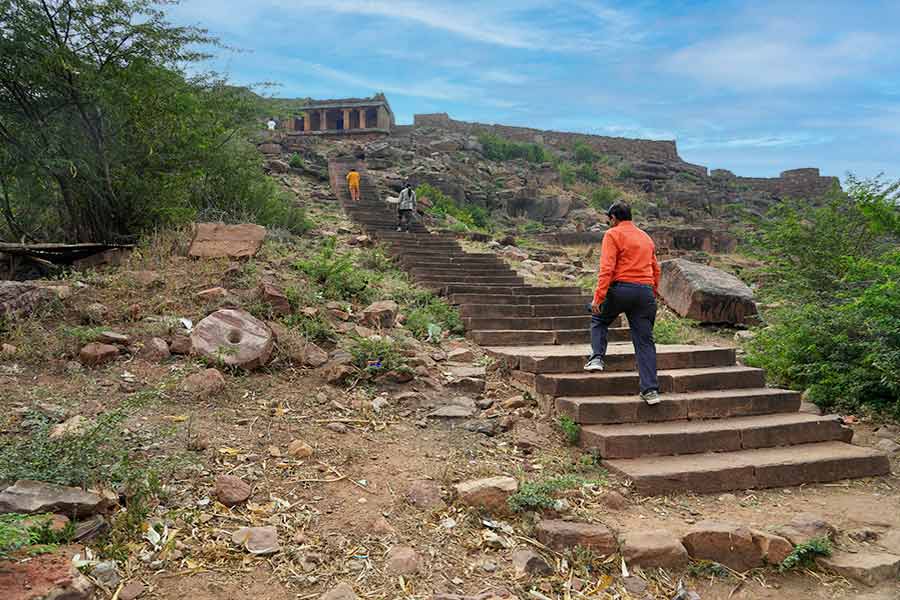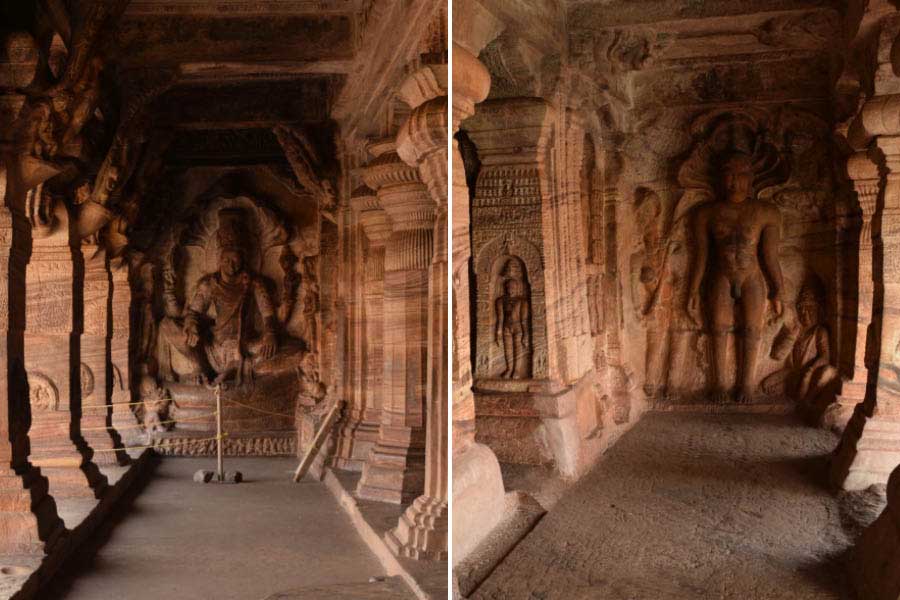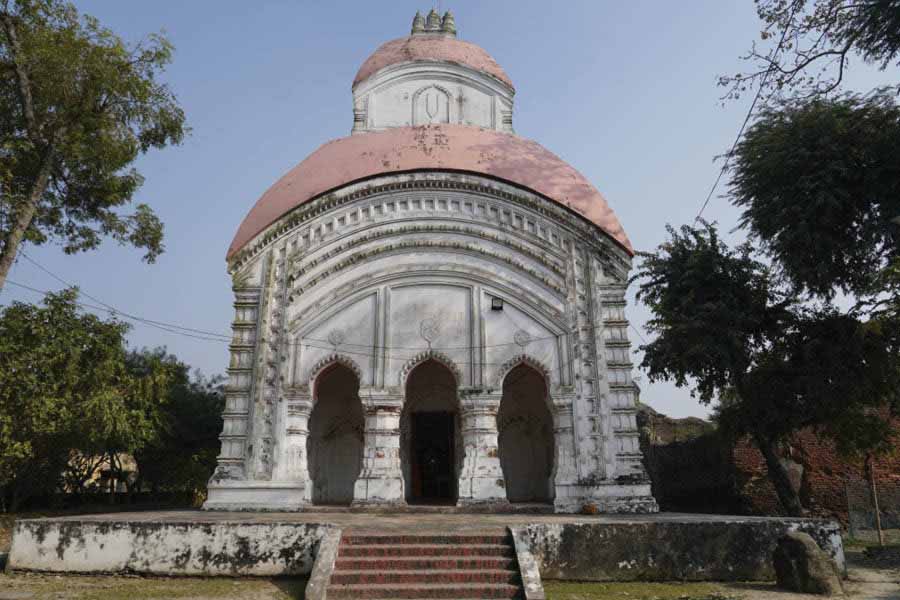Aihole witnessed the earliest art of early Chalukyas as their first capital before their dynasty rose to fame with their ruler Pulakesi I, who had their capital shifted to Badami or Vatapi. Earlier to Pulakesi I, Jayasimha and his son, Ranaraga, were their first rulers during beginning of the 6th century. Their names are mentioned in an inscription on a pillar dated 602 AD at Mahakuta located 15km east of Badami.
Located in Karnataka and situated near the right bank of Malaprabha river, about 35km northeast from Badami via Pattadakal, the religious shrines of Aihole may be divided into two eras – one extending between the 6th and 8th centuries belonging to the early Chalukyas and later, the Rashtrakutas and the second extending between the 10th and 12th centuries belonging to the late Chalukyas. Around 500 metres of fortified walls surrounding the city still remains.
Some of the major temples of Aihole are intriguing.
Meguti hill Jain temples
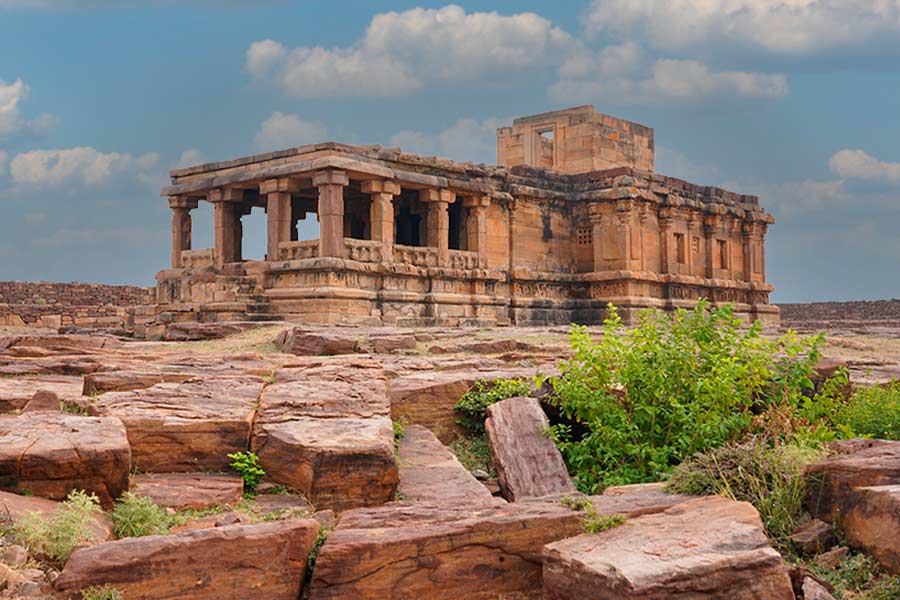
The Jain temple atop Meguti hill surrounded by fortified walls.
Start your heritage tour with the Meguti hill. One needs to climb a long flight of stairs to reach the top of the hill. Just below the crest of the hill is a two-storeyed Buddhist temple with colonnades on each floor. A headless statue of Buddha can be seen outside the shrine. On the ceiling of the top floor colonnade, there is a carving of Buddha in a seating posture.
On top of the Meguti hill stands a north-facing Jain temple on a vast open space surrounded by rubble walls. On its eastern wall is a grey stone slab with an inscription dating to 634 AD comprising 19 lines of poem of written in old Chalukyan script composed by Ravikirti, the court poet of Pulakesi II (610-642 AD).
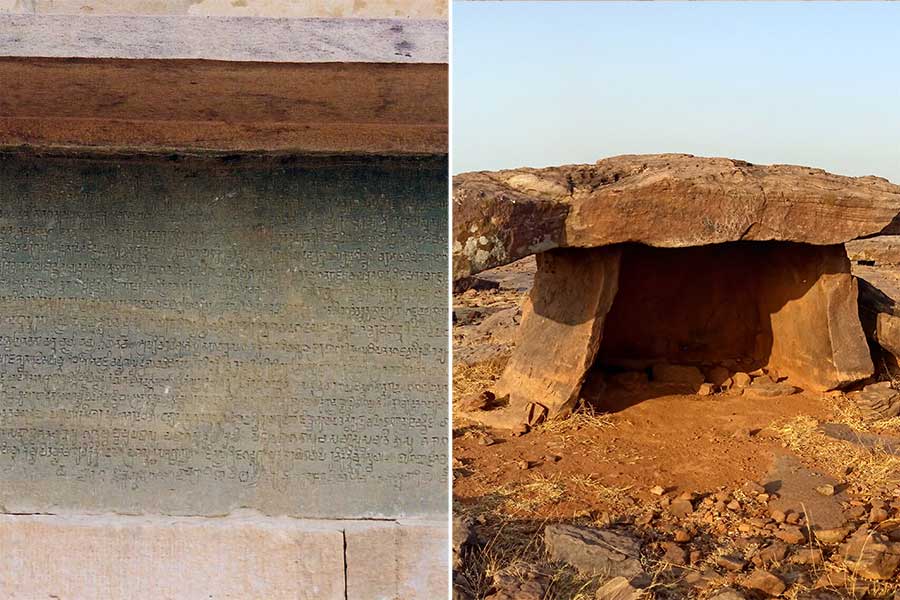
The Aihole inscription of Ravi Kirti at the Meguti temple dating to 634 AD. Its last two lines were added at a later date and (right) pre-historic Dolmens at Meguti hill Wikimedia Commons
The poem provides a detailed description of the early Chalukya families and their exploits. The flat-roofed temple has a pillared open porch adjoined by a closed inner sanctum with a circumbulatory pathway. The inner sanctum has a figure of a naked meditating but defaced Jain Tirthankar sculpted on its wall.
A series of prehistoric dolmens (dating back to 2nd – 1st millennia BC) are located on the lower southern part of the hills. If you want to visit them, get down from the hill and track backward on the main road for 1km to venture a side road and access the dolmens as well as a 6th to 7th century rock-cut temple with an interior studded with rich carvings.

Durga Temple Complex (500m northwest of Meguti Hill)
The 8th century-built Durga temple in the complex has a misleading name. George Michell, an authority on South Asian architecture, says that the temple “came to be known as Durga when a stone rubble durg, or a fortified lookout, was raised upon its roof (now removed)”. The temple architecture resembles a Buddhist chaitya. The architecture of the temple is predominantly Dravida with Nagara style being used in certain areas. The temple has an entrance porch to the east with an outer colonnade verandah on a high basement.
The Durga temple comprises a mukhamandapa, a sabhamandapa and a garbhagriha with a circumbulatory passage. The roof before the entrance to the mukhamandapa is decorated with various figure and motifs. The colonnade verandah has several life-sized figures of several deities. A gateway with a passage adjacent to the temple with an icon of Surya carved on it have made many historians opine that the Durga temple was originally dedicated to the Sun god.
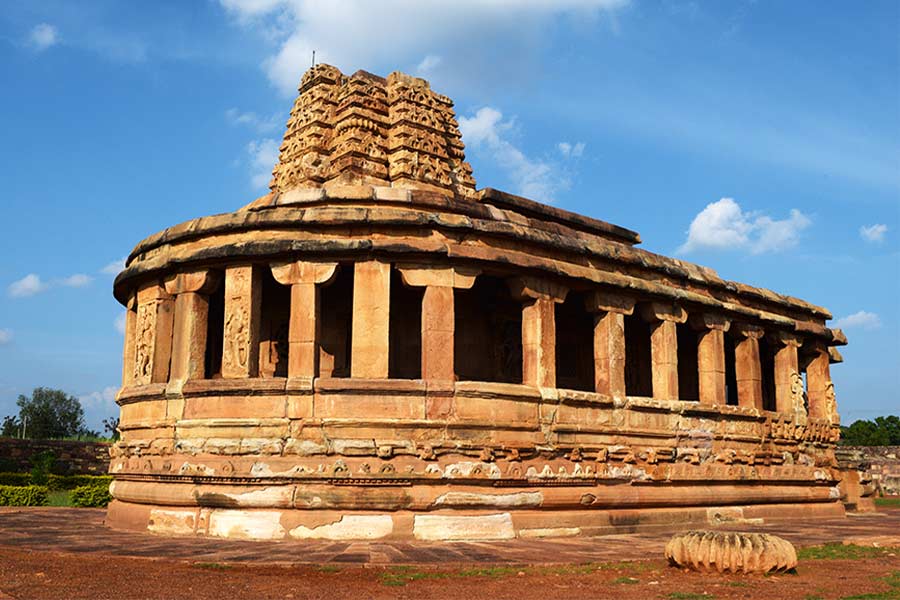
Durga Temple at Aihole.
Among other major temples inside the Durga temple complex, the Lad Khan temple (7th to 8th century), is named after a Muslim nobleman of yesteryears who had his residence here. This temple is divided into a square-pillared hall and a rectangular pillared porch. The porch columns have decorative reliefs.
The Suryanarayana temple (7th century) has a seated image of Surya holding two lotuses over the doorway its garbhagriha. Inside the shrine is a chlorotic schist (metamorphic rock) built image of Surya.
Gaudaragudi
It (5th century) was earlier known as Mahalakshmi or Bhagavati temple. A long inscription engraved on a lintel in front of the temple indicates it was dedicated to goddess Gauri.
A large tank with many ancient sculptures carved on its wall stands between Chakragudi and Gauragudi. Chakragudi temple has 20 sculptures of amorous couple engraved on the doorframe of the sanctum and a nagara-styled shikhara adorned with an amalaka looms above the garbhagriha. The temple is believed to be built in the 7th century by Chalukyas and later extensively renovated by Rashtrakutas in the 9th century. Also attributed to the Rashtrakuta period is the Badigera Gudi at extreme southwest corner of the complex with a pyramidal tower.
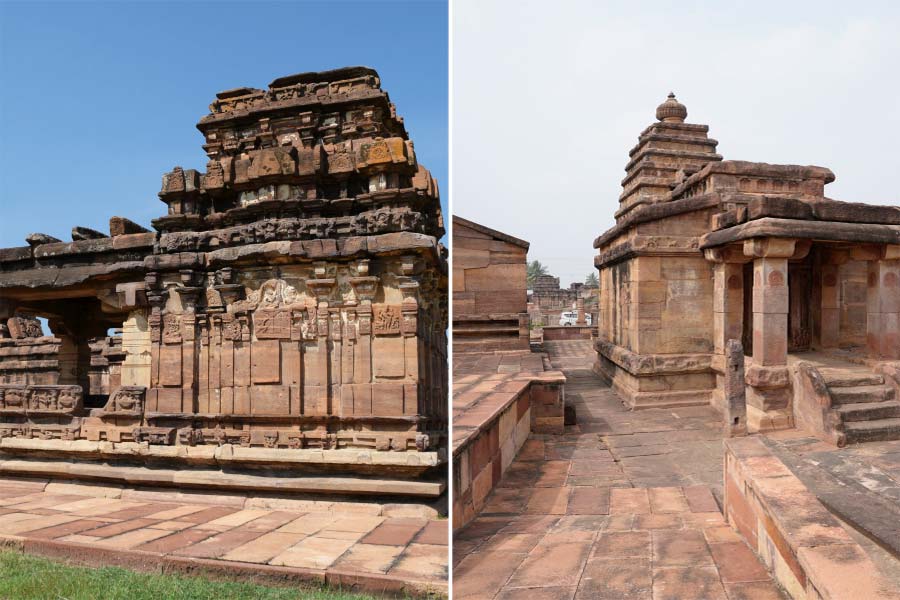
One of the temple of Galagnatha temple complex and (right) interiors of Mallikarjun temple complex
The Durga temple complex also houses the Archaeological Survey of India Museum of Aihole. Its highlights are a large-scale model of Aihole and its monument displayed in an open-air inner court and a deeply carved panel of Goddess Ambika removed from Jain temple at Meguti hill.
Hucchimalligudi
Driving north from the gate of Durga temple complex for around 300m, one needs to turn eastwards and drive for above 100m to reach the Hucchimalligudi temple (6th century). The shrine stands on an elevated platform and has a mukhamandapa, a rangamandapa and garbhagriha with unique sculptural designs. The temple is a Shivalaya with an inscription which records a grant of oil to the priest of the temple by Chalukya king Vijayaditya (696 to 733-734) in 708 CE. The garbhagriha has a towering rekha nagara shikhara over it. A tank in the premises has its walls full of fine sculptures.
Ravanaphadi

Interiors of Ravanphadi cave temple, Aihole, and (right) the life-sized 10-armed Shiva in a posture of a cosmic dance with other deities inside it
About 200m south of Hucchimali Gudi stands Ravanaphadi – a cave temple dating to the late 6th century. The main attraction is a life-sized 10-armed Shiva in a posture of a cosmic dance accompanied by Parvati, all seven saptamatrikas, as well as Ganesh and Kartikeya.
Other temples of Aihole
Before entering the city (1km south from Aihole dolmens)
1. Galaganatha Temple Complex (8th century) with several medium and small temples built in both Dravidian and Nagara styles.
2. Ramalingeshavara temple complex besides the Malprabha river with three temples and a common Mandapa.
Southern part of the city around Meguti Hill
1. Mallikarajun group of temples. There are five temples here with a water tank. The main temple is from early Chalukya period and others from late Chalukya period.
2. 12th century Trimabakesvara temple
3. Konti Gudi temple complex featuring both Early Chalukyas and Rashtakuta period shrines
4. 7th century Hucchappayamatha temple which many believe to be a simply a dwelling for priests
5. 12th century Gauri temple, the largest and most elaborate Late Chalukya period temple in Aihole.
6. 11th century Jain temple complex housing a basalt sculpture of Parshvanatha seated on a lion throne.
Near the Gate of Durga temple complex
1. Jyotirlinga Temple Group on the North eastern side. It comprises 16 small and big temples.
It has a 11th century Vishnu temple, 12th century Sangamanatha temple, an 8th century Shivalaya and also a Parashurama shrine.
2. Chikki Temple complex on the North west side with plain exteriors but in the inner mandapa there are exquisitely designed columns as well ceiling panels carved with figure of divinities.
3. Ambigera Gudi Complex on western side housing two temples from 7th to 8th century and another from 11th century. Further south of this temple stands the Rachi Gudi Temple – an 11th century Shiva temple with three Garbhagriha (Trikutachala).
